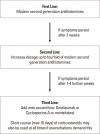Guideline of Chronic Urticaria Beyond
- PMID: 27334777
- PMCID: PMC4921693
- DOI: 10.4168/aair.2016.8.5.396
Guideline of Chronic Urticaria Beyond
Abstract
Urticaria is a relatively common condition that if chronic can persist for weeks, months or years and affect quality of life significantly. The etiology is often difficult to determine, especially as it becomes chronic. Many cases of chronic urticaria are thought to be autoimmune, although there is no consensus that testing for autoimmunity alters the diagnostic or management strategies or outcomes. Many times, urticaria is easily managed with antihistamines and/or short courses of oral corticosteroids, but too often control is insufficient and additional therapies must be added. For years, immune modulating medications, such as cyclosporine and Mycophenolate Mofetil, have been used in cases refractory to antihistamines and oral corticosteroids, although the evidence supporting their efficacy and safety has been limited. Omalizumab was recently approved for the treatment of chronic urticaria unresponsive to H1-antagonists. This IgG anti-IgE monoclonal antibody has been well demonstrated to safely and effectively control chronic urticaria at least partially in approximately 2/3 of cases. However, the mechanism of action and duration of treatment for omalizumab is still unclear. It is hoped that as the pathobiology of chronic urticaria becomes better defined, future therapies that target specific mechanistic pathways will be developed that continue to improve the management of these often challenging patients.
Keywords: Urticaria; angioedema; diagnosis; guidelines; hives; management.
Conflict of interest statement
There are no financial or other issues that might lead to conflict of interest.
Figures
References
-
- Zuberbier T, Aberer W, Asero R, Bindslev-Jensen C, Brzoza Z, Canonica GW, et al. The EAACI/GA(2) LEN/EDF/WAO Guideline for the definition, classification, diagnosis, and management of urticaria: the 2013 revision and update. Allergy. 2014;69:868–887. - PubMed
-
- Bernstein JA, Lang DM, Khan DA, Craig T, Dreyfus D, Hsieh F, et al. The diagnosis and management of acute and chronic urticaria: 2014 update. J Allergy Clin Immunol. 2014;133:1270–1277. - PubMed
-
- Schocket AL. Chronic urticaria: pathophysiology and etiology, or the what and why. Allergy Asthma Proc. 2006;27:90–95. - PubMed
-
- Kaplan AP. Chronic urticaria: pathogenesis and treatment. J Allergy Clin Immunol. 2004;114:465–474. - PubMed
-
- Frigas E, Park MA. Acute urticaria and angioedema: diagnostic and treatment considerations. Am J Clin Dermatol. 2009;10:239–250. - PubMed
Publication types
LinkOut - more resources
Full Text Sources
Other Literature Sources



